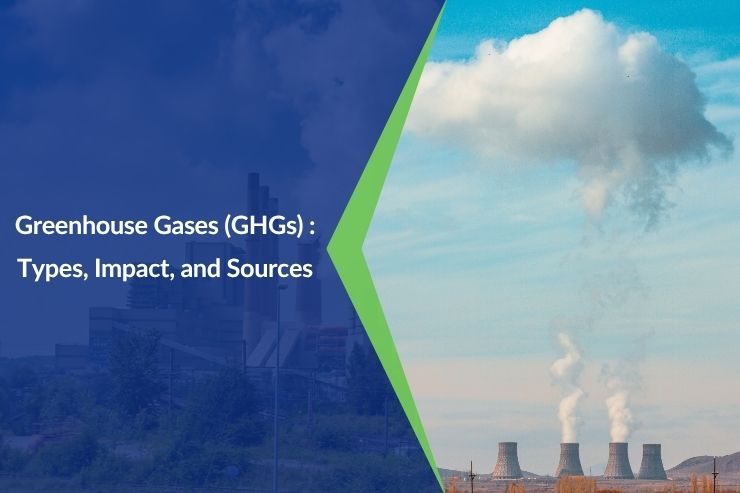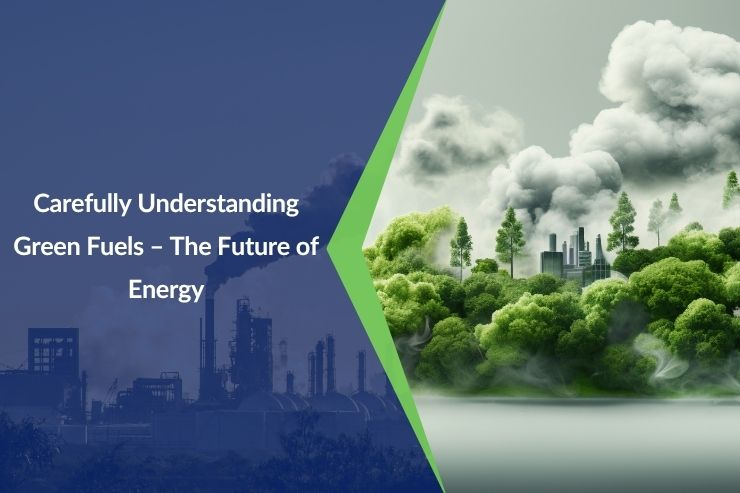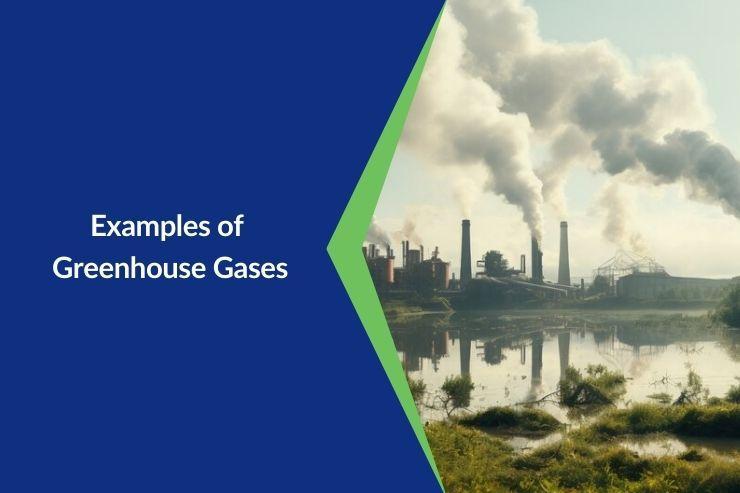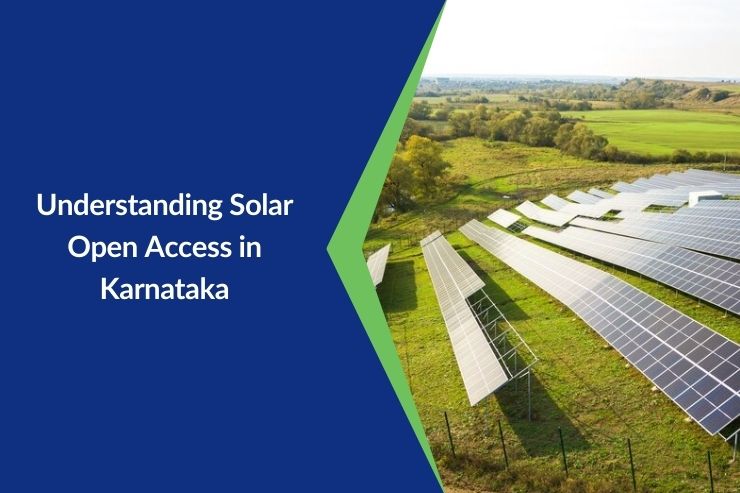What are Greenhouse Gases?
Greenhouse gases (GHGs) refer to gases present in the Earth’s atmosphere that trap heat. They let the Sun rays come into the atmosphere freely, where the Earth absorbs them. Then, they trap the warmth when the Earth tries to radiate it back into space, playing a crucial role in the greenhouse effect, which keeps our planet warm enough to support life.
Types of Greenhouse Gases (GHGs)
Greenhouse gases (GHGs), including carbon dioxide, methane, nitrous oxide, and fluorinated gases, play crucial roles in the climate system. Each has unique properties and effects on the atmosphere, contributing distinctly to the greenhouse effect and global warming.

Carbon Dioxide (CO₂)
Carbon Dioxide (CO₂) is the most prevalent greenhouse gas, primarily produced by burning fossil fuels and deforestation.
Methane (CH₄)
Methane (CH₄), more potent than CO₂ in trapping heat but shorter-lived, primarily comes from agriculture, waste management, and energy industries.
Nitrous Oxide (N₂O)
Nitrous Oxide (N₂O) has a longer atmospheric lifespan and mainly originates from agricultural activities and fossil fuel combustion.
Although Less Common, Fluorinated Gases
Synthetic compounds from industrial applications, have heat-trapping solid capabilities.
Sources of Greenhouse Gases (GHGs)
The origins of greenhouse gases are diverse, ranging from volcanic eruptions to industrial emissions. Natural processes and human activities release these gases into the atmosphere, each adding to the layers of complexity in our climate system.
Natural Sources
These include volcanic eruptions, which release gases and particulates into the atmosphere, natural biological processes in soil, and ocean releases.
Human Activities
Human sources are diverse, encompassing fossil fuel combustion in energy and transportation, industrial processes, agricultural practices that release methane and nitrous oxide, and deforestation, which impacts carbon storage capacities.
How Long Do Greenhouse Gases Stay in the Atmosphere?
The atmospheric lifespans of these gases vary enormously—from a few years to millennia. These durations are vital in understanding their impact on climate change and the urgency to address their emissions.
Carbon Dioxide (CO₂): may linger in the atmosphere for hundreds to thousands of years, significantly impacting climate systems in the long term.
Methane (CH₄): typically lasts about 12 years before it degrades, influencing short-term climate phenomena more than CO₂.
Nitrous Oxide (N₂O): stays around for about 114 years, contributing long-term to the greenhouse effect.
Fluorinated Gases: vary in lifespan, generally persisting for decades or centuries, depending on their specific chemical properties.
The atmospheric lifespan of these gases dictates the duration of their impact on climate patterns, posing challenges in climate change mitigation efforts.
How Strongly Do Greenhouse Gases Impact the Atmosphere?
The greenhouse effect and their global warming potential (GWP) measure the impact of greenhouse gases. This effect is a natural process warmed by the Earth’s atmosphere. Without it, our planet would be too cold to support current life forms.
Global Warming Potential (GWP): compares different gases based on how much heat they trap in the atmosphere over a specific period, typically 100 years. For example, methane has a GWP many times higher than that of carbon dioxide, making it much more effective at warming the Earth on a per-molecule basis.
Consequences of enhanced greenhouse effects include rising global temperatures, altered weather patterns, and significant ecological impacts.
Impact of Greenhouse Gases (GHGs) on Climate Change
Greenhouse gases drive significant changes in our climate, altering weather patterns and influencing global temperatures and sea levels. Their impact is profound, affecting biodiversity, human health, and the global economy.
Extreme Weather Events
Increases in greenhouse gases are linked to more severe weather patterns, including hurricanes, droughts, and heavy rainfall.
Rising Sea Levels and Melting Ice Caps
As temperatures rise, ice caps melt, and sea levels rise, which can lead to coastal erosion and affect low-lying communities.
Effects on Biodiversity and Ecosystems
Flora and fauna struggle to adapt to changing climates, leading to biodiversity and ecosystem services shifts.
Socio-Economic Implications
Climate change can impact food security, water resources, and general health, leading to economic losses globally.
What Can Be Done to Reduce Greenhouse Gases (GHGs)?
Mitigating the effects of greenhouse gases is possible through various strategies, from technological innovations in energy production to shifts in agricultural practices. Each approach offers a pathway to reduce emissions and curb global warming.
Transition to Renewable Energy Sources: such as solar, wind, hydro, and geothermal to decrease reliance on fossil fuels.
Enhancing Energy Efficiency: in buildings, industries, and transportation can significantly cut emissions.
Sustainable Transportation Solutions: include promoting electric vehicles, enhancing public transportation systems, and developing cycling infrastructures.
Carbon Sequestration Techniques: such as afforestation, reforestation, and technological carbon capture and storage, can directly remove CO₂ from the atmosphere.
Sustainable Agricultural Practices: such as improved crop rotation, reduced fertiliser use, and capturing methane from livestock can diminish agriculture’s carbon footprint.
What Are We Doing to Reduce Greenhouse Gases at National Grid?
National Grid is actively engaged in Sustainability Initiatives, investing in renewable energy projects and modernising infrastructure to reduce emissions. Their Emission Reduction Targets reflect ambitious short-term and long-term goals, with significant progress already made. Community Engagement and Education efforts are crucial, involving local organisations and governments to promote sustainable practices widely.
The Future of Greenhouse Gases and Global Climate Goals
As the global community faces the challenge of reducing greenhouse gas emissions, international agreements and innovative technologies play critical roles. These efforts are essential for achieving the ambitious climate goals to safeguard the planet’s future.
International Agreements: such as the Paris Agreement, set worldwide objectives to mitigate greenhouse gases and national commitments, which are crucial in setting goals and providing frameworks for action.
Emerging Technologies and Innovations: in clean energy, sustainable materials, and emission monitoring technologies are being developed rapidly, promising further reductions in greenhouse gases.
The Role of Individuals and Communities: in advocating for and adopting sustainable practices is also vital, emphasising that everyone has a part to play in addressing climate change.
Conclusion
As we work through the complexities of greenhouse gases and their impacts, collective efforts in innovation, policy, and community engagement are essential for achieving global climate goals. By understanding and addressing the sources and effects of these gases, we can work towards a more sustainable future for all.
PDF: Details for Reduction in Green House Gases achieved
Frequently Asked Questions
What are The Primary Greenhouse Gases?
The primary greenhouse gases include carbon dioxide, methane, nitrous oxide, and fluorinated gases, each contributing differently to the greenhouse effect.
How Long Do Greenhouse Gases Remain in The Atmosphere?
These gases can stay in the atmosphere for years to millennia, with carbon dioxide lasting the longest and methane the shortest among the major gases.
What are The Natural Sources of Greenhouse Gases?
Natural sources include volcanic eruptions, natural biological processes in soil and water, and respiration by specific organisms.
Why is Methane Considered a Potent Greenhouse Gas?
Methane is highly effective at trapping heat in the atmosphere, making it much more potent per molecule than carbon dioxide in the short term.
What Role Do Fluorinated Gases Play in Climate Change?
Though less common, fluorinated gases have a strong greenhouse effect and can stay in the atmosphere long.
How Does Deforestation Contribute To Greenhouse Gas Emissions?
Deforestation reduces the number of trees that can absorb carbon dioxide, thus increasing the amount of gas in the atmosphere, contributing to global warming.









